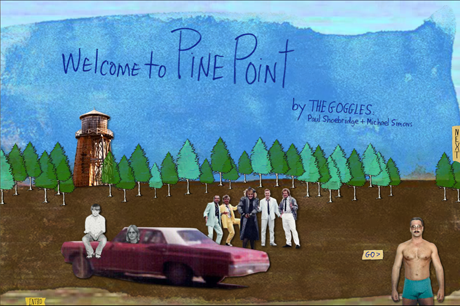
A great story once began: It was the best of times, it was the worst of times. For the art of journalistic storytelling these days, it’s both.
It's the best of times because we have a wealth of storytelling tools at our disposal today unlike anything we've seen before: video, audio, interactive features, mapping, data visualization, simulations, computational gadgets, the ability to link to the world's knowledge. The ways that we can tell a story these days are virtually limitless.
But it's the worst of times because most news stories still are being told the old-fashioned way: in text, often via an inverted pyramid, with a lede, a couple of quotes, a nut graf, and on and on for hundreds or thousands of words, pretty much the same way stories have been told since, well, Charles Dickens wrote "Tale of Two Cities” and long before that.
Those written storytelling conventions arose, logically, out of our oral traditions – as written language developed, it made sense to commit stories to paper using only words.If, as the saying goes, a picture is worth a thousand words, what's a video worth? Or a simulation? Or some other form of multimedia or interaction?Mark Potts
But it's illogical today, with so many alternatives available, to keep telling the vast majority of stories the same way we always have. Some stories lend themselves to so much more than words, and we now have the ability to better match the form to the story.
Sure, there have been notable exceptions to the dominance of the written word. Everybody seems to point to the New York Times' famous 2012 effort, "Snow Fall: The Avalanche at Tunnel Creek", which brought together graphics, maps, links and interactive features – albeit with a backbone of standard text. Not everyone is as taken with “Snow Fall”, but in a frozen wasteland of old-fashioned storytelling, it stood out.
It certainly wasn’t the first effort to try to tell stories with multimedia. The Philadelphia Inquirer’s mammoth “Black Hawk Down” project, back in 1997, was one of the first to combine audio, video, documents and other elements with conventional text.
More recently, in 2010, The Washington Post’s Ian Shapira, told a moving story of a woman's Facebook chronicle of her declining health and death after childbirth by using Facebook's own features and format to tell the story. The result was still heavily text-based, but it demonstrated a creative use of computational media. The medium became the message.
More ambitiously, Nate Silver's FiveThirtyEight.com has marshaled data to find new ways to tell stories – although supposedly cutting-edge journalism enterprises such as FiveThirtyEight, Vox and Pierre Omidyar's First Look still rely largely on text to get their stories across. Even something like The Washington Post's much-vaunted new Storyline feature turns out to be the same-old, same-old presentation of text, dressed up in a fancy layout. That's not enough.
Fortunately, there are other, more advanced examples of creative use of new journalistic storytelling tools – especially using computation, data and maps – though they’re still too few and far between.
The New York Times has a longstanding, regularly updated interactive feature that lets readers simulate the tough choices needed to balance the federal budget. A recent interactive Times feature tracked how Americans move away from the states in which they were born. And the Times used an interactive map to track the dispersal of surplus military equipment to local police forces, a story that more traditionally might have been told through inches of dry text and a few anecdotes.

Screenshot from Welcome to Pine Point
One of the most ambitious examples of advanced multimedia storytelling is “Welcome to Pine Point,” an exploration of a defunct mining town by Canadian documentarians Michael Simons and Paul Shoebridge, in association with the National Film Board of Canada. Seamlessly blending video, sound, maps, text, interactivity and other elements, “Welcome to Pine Point” presents a rich storytelling experience that makes even “Snow Fall” look traditional.
Other notable recent multimedia efforts include The Guardian’s “Firestorm”, The Tennessean’s “Because of You”, and PBS/Frontline’s “A Perfect Terrorist”, which uses video in unusual non-linear and interactive ways.
To be sure, these sorts of ambitious multimedia and computational storytelling projects are not easy to create. They require multiple skills (video, audio, programming, etc.) and, generally, teams of people. It’s usually a lot simpler and less expensive to tell a big story with a few thousand well-chosen words. And let's face it. It's easy to fall back on the tried and true text-storytelling tricks.
But we've got much better tools today. Simulations and newsgames can put readers – even that word implies text-first formats – into the middle of a story, experiencing and interacting with it directly. Appropriate use of tools like data, video and audio, especially mixed together and with other forms (yes, even words) can provide a much richer storytelling experience.
If, as the saying goes, a picture is worth a thousand words, what's a video worth? Or a simulation? Or some other form of multimedia or interaction?As we continue to explore the new technological tools available to us, it is likely that new forms of storytelling will emerge and take holdMark Potts
Ironically, as we continue to search for new forms of storytelling that mix and match these amazing new tools to create a new vocabulary for sharing stories, we're seeing greenshoots of new kinds of storytelling.
The 140 characters of Twitter, used well, can get across large amounts of information, and encourage interaction with the audience that adds to the story. Check out one of Silicon Valley magnate Marc Andreessen's famous tweetstorms (@pmarca) to see how a dozen sharp tweets can express deep thoughts and trigger fascinating discussion.
Twitter’s value as a staccato breaking news bulletin service, of course, is well-known, as was recently demonstrated again by dramatic coverage by The Washington Post’s @WesleyLowery and others of the police killing of Michael Brown and the subsequent unrest in Ferguson, Missouri. Storify collections of tweets and liveblogging are other tools to tell rapidly-changing stories in new ways.
Similarly, lists and slide shows can convey volumes of info in an economical few lines or clicks. Many journalists don't usually think of these as storytelling media – indeed, we often deride them – but they are providing new and entertaining ways to tell tales, as the success of Buzzfeed and other 'listicle' purveyors demonstrate.
It's worth noting that online business publication Quartz recently posted a job opening for a reporter to create what it called 'Things', explaining that "'Thing' is simply our catchall term for stories that break free of the traditional article format to convey information in ways that work better on the web. Developing those new storytelling methods – and empowering others to use them, as well – is the challenge of this job." Hear hear.
As we continue to explore the new technological tools available to us, it is likely that new forms of storytelling will emerge and take hold. They may not supplant text, but hopefully they will greatly supplement it, at the very least. We must recognize that every subject we cover demands its own unique storytelling. A visual story benefits from visuals rather than written descriptions.
A story based on data needs to show, rather than tell. Twenty years into the digital revolution, we're still trying to invent the best way to tell stories. As we do, the best of times will be ahead.
Footnote: Josh Stearns, director of journalism and sustainability for the Geraldine R. Dodge Foundation, has compiled an excellent list of interesting online storytelling examples over the past couple of years that can be found here and here.
 Mark Potts is a leader in the development of innovative strategies and products in online and print media. He created one of the first electronic news prototypes in the early 1990s, and then co-founded The Washington Post Co.’s digital division. As co-founder of Backfence.com and GrowthSpur, he was a pioneer in the field of hyperlocal news and information. In 2014, Mark founded Newspeg.com, a visual news-sharing site that has been described as "Pinterest for news.”
Mark Potts is a leader in the development of innovative strategies and products in online and print media. He created one of the first electronic news prototypes in the early 1990s, and then co-founded The Washington Post Co.’s digital division. As co-founder of Backfence.com and GrowthSpur, he was a pioneer in the field of hyperlocal news and information. In 2014, Mark founded Newspeg.com, a visual news-sharing site that has been described as "Pinterest for news.”
Free daily newsletter
If you like our news and feature articles, you can sign up to receive our free daily (Mon-Fri) email newsletter (mobile friendly).
Related articles
- What AI can do for your newsroom: tips from Ring Publishing's latest handbook
- 200 speakers you need at your next journalism event to avoid all-male panels
- How young leaders can shape the future of the media industry
- Tools, tactics, and success stories of newsroom innovation in 2023
- How news brands can win over young audiences, with Danuta Breguła









